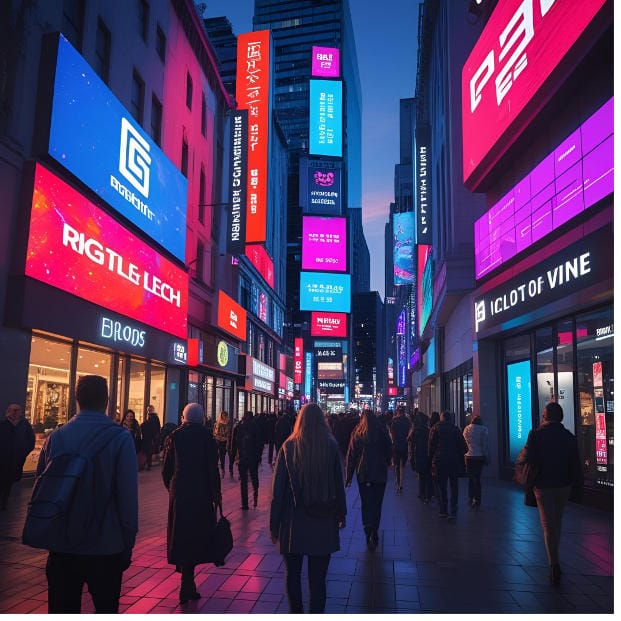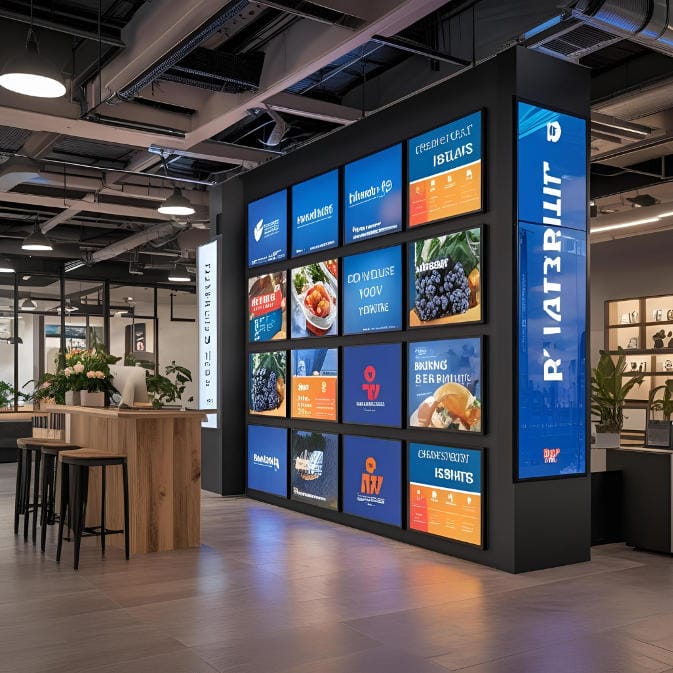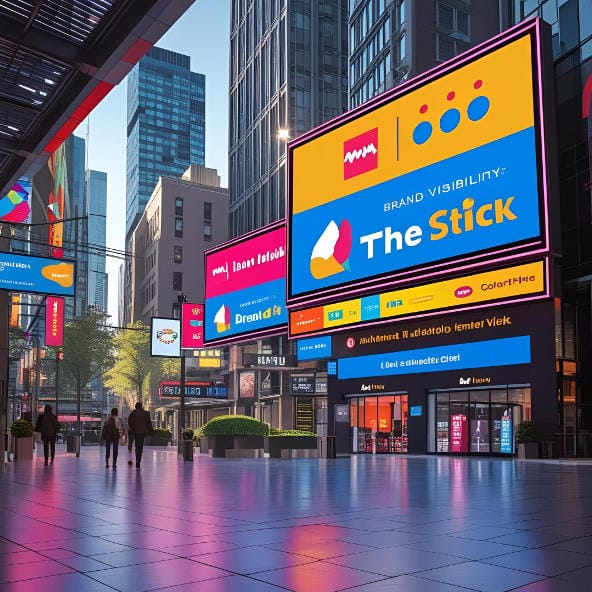In a time where customers are overwhelmed with advertisements, Digital Signs for Brand Visibility is a strong method of making a difference. However, even the most sophisticated screens can wear out when the content becomes stale. The following are some of the strategies that combine the expertise of the most well-known digital signage brands and digital advertising agencies to make sure your screens stay alive, topical, and productive.
 1. Why Fresh Digital Signs Matter
1. Why Fresh Digital Signs Matter
Your screens must not be filled with stale content that will compromise your brand credibility. Passersby will get desensitized to the same message every day, and that chance of awareness, engagement, and conversion is lost. By maintaining your Digital Signs for Brand Visibility, you strengthen professionalism, show that your brand is active, and use time-sensitive promotions and seasonal campaigns.
2. Understanding Your Audience
Demographic Insights
Determine the type of viewers you have, whether they are shoppers, commuters, or diners, and adjust your messaging accordingly. To illustrate an instance, fashion stores may present new stocks to fashion-conscious young people, and transit-oriented displays may target fast grab offers to busy professionals.
Contextual Relevance
A screen in a luxury shopping center needs glamorous visuals and luxury offers; a screen in a coffee shop is better off with drink specials and social media mentions. Leading digital advertising companies perform foot traffic research to match content and viewer intent.
3. The Power of Visual Design in Digital Signs
Visual Hierarchy
Design each slide in one clear point: one headline, one image, one call to action. This is the methodology that is being popularized by the major providers of digital signage solutions, so that your main message does not get lost in the crowd.
Typography and Color
Use the color scheme of your brand and save the accent colors to use in call-to-actions such as Shop Now or Limited Time Offer. Use fonts of high contrast and sans serif type to ensure readability, even at a distance.
4. Content Rotation Strategies
Thematic Campaign Bundles
Instead of updating random slides, organize the content in mini campaigns. As an example, a “Spring Refresh” campaign line might contain new product highlights, customer reviews, and a countdown to your April sale, but be refreshed each week and remain unified.
Social Media Incorporation
Link your Digital Signs for Brand Visibility to live Instagram or Twitter feeds. Photos of customers tagged by users are an example of user-generated content that is authentic and keeps itself up to date, thus less manual updating is required.
 5. Incorporating Dynamic Content
5. Incorporating Dynamic Content
Weather‑Triggered Promotions
Automate slides rotate based on real-time weather data, i.e., highlight hot beverages when the temperature drops to below 50°F.
Countdown Timers and Live Tickers
Include countdowns on sales that have a time limit and news tickers that scroll to ensure all the information is up to date. Such moving objects are able to keep the viewers more attentive than still pictures.
6. Scheduling and Dayparting
Morning Highlights
Promote breakfast offers coffee promotions, or sayings like good morning with optimistic images.
Midday Specials
Market lunch specials and fast deals that fit the 11:00 AM 2:00 PM demographic, with speed and affordability.
Evening Engagement
Move to dinner menus, happy hour specials, or events this weekend, changing the tone and the visuals to be more casual and welcoming.
7. Seasonal and Event‑Based Updates
Holiday Storytelling
Create multi-week structures around key holidays: hint at future Christmas offers in November, reveal Black Friday deals, then switch to New Year’s offers, with all of them unified branding.
Local Tie Ins
Market the local community festivals or sports events with themed content, such as displaying community team colors or sponsoring halftime specials, which reminds your brand is a part of the community.
 8. Brand Consistency vs. Visual Variety
8. Brand Consistency vs. Visual Variety
Take a modular template strategy: dedicate fixed space to your logo and brand colors, and replace flexible space with rotating product images, offers, or social streams. This balance makes your quick service, restaurants or retail brand easily recognizable and provides new visuals at the same time.
9. Using Data to Refresh Content
Engagement Analytics
Watch the dwell times and the number of interactions (on touchscreens) to see which slides are connecting.
Sales Correlation
Cross-check schedules of promotional slides and point of sale data to identify the offers that deliver the greatest uplift to inform future content priorities.
Heat Mapping Insights
Attention heat maps can be provided by some digital signage solution suppliers, revealing the precise location where viewers look at it, enabling strategic placement of CTAs.
10. Choosing the Right Digital Signage Software
When you are working with digital advertising firms, seek a CMS that provides:
- Remote Management: Manage multiple sites with one point of interface.
- Template Libraries: Get a professionally designed layout and brand-approved modules.
- Integration: Smooth inter-connectivity with social, weather, and POS.
- Scheduling: Dayparting, automation of campaigns, and emergency override.
This will make your Digital Signs for Brand Visibility remain fresh with very little operational load.
11. Mistakes to Avoid
- Over Updating: Slides should have time to sink in; 6-10 seconds per slide is recommended.
- Branding inconsistency: Branding that does not adhere to the core elements of a brand is confusing, not engaging.
- Crammed Designs: An excess of texts or images overwhelms the viewers.
- Neglecting Performance Data: The failure to do analytics will lead to the loss of growth opportunities.
Be deliberate: plan the updates ahead of time, test content during pilot runs, and scale what is effective.
12. Future‑Proofing Your Digital Signage Strategy
Invest in a cloud native digital signage that can support:
- AI Personalization: The content is tailored to the demographics of the viewer or environmental cues.
- Interactivity: QR-enabled campaigns, touchscreens, and motion sensors enabled a greater level of interaction.
- Sustainability: Energy-friendly hardware and solar-power alternatives to cut down the carbon footprint.
Digital signage brands that think ahead are always innovative; your signage strategy should follow.
Ready to Keep Your Digital Signs Fresh?
Team up with Nento, a pioneer in digital advertising brands, to use our complete range of digital signage services and interactive digital signage software. If you are updating one lobby display or installing an enterprise-level network, we can keep you up to date with visually compelling, data-driven Digital Signs for Brand Visibility that will captivate and convert. Call us now to get a free consultation!
 FAQs: Digital Signs for Brand Visibility
FAQs: Digital Signs for Brand Visibility
What makes digital signs effective for brand visibility?
Digital signs increase brand exposure through high-impact imagery, real-time messaging, and content rotation. By collaborating with leading brands in the digital signage industry, you will be able to make your displays an effective advertising tool that helps to attract attention and stimulate brand memory.
How often should I refresh content on my digital signs?
The goal is to refresh core promotional content once every week and dynamic feeds (weather, social media) once a day or every hour. This makes your digital signs for brand visibility advertising interesting and relevant, avoiding message fatigue.
Which digital signage software is best for brand visibility?
Find a cloud-based CMS that provides an easy-to-use design, scheduling/dayparting capabilities, and social media or POS integration. The top digital advertising providers, such as Enplug, Spectrio, and BrightSign, offer powerful platforms that are customized to refresh content.
Can digital signs for brand visibility drive measurable sales lift?
Yes. It has been found that effective digital signage campaigns can increase sales by 5-15 percent with customized promotions, data-informed upsells, and time-sensitive offers on your digital menu board or video walls.
What are common mistakes to avoid with digital signs?
Do not update content rarely, have uneven branding, and overly busy designs. When you choose a reliable digital signage solution, you will have quality visuals, a consistent brand image, and frequent content refresh.
How do I measure the ROI of my digital signs?
Monitor screen dwell time, social media engagement, and sales correlation using built-in analytics. When you combine these metrics with the data of foot traffic, you will get clear information on the effectiveness of your digital signs for brand visibility advertising.
Do I need professional design support for my digital signs?
Although there are a lot of platforms with Free templates for restaurants and DIY tools, collaborating with digital advertising brands or creative agencies will take your visuals to the next level, which means on-brand, SEO friendly content that will make the most out of the engagement.


 1. Why Fresh Digital Signs Matter
1. Why Fresh Digital Signs Matter 5. Incorporating Dynamic Content
5. Incorporating Dynamic Content 8. Brand Consistency vs. Visual Variety
8. Brand Consistency vs. Visual Variety FAQs: Digital Signs for Brand Visibility
FAQs: Digital Signs for Brand Visibility


